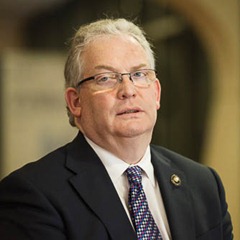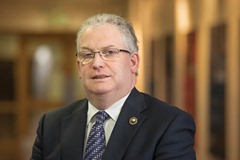Health: meeting the challenges
 As the restructuring of the HSE approaches, Director-General Tony O’Brien discusses the drivers for change with Owen McQuade.
As the restructuring of the HSE approaches, Director-General Tony O’Brien discusses the drivers for change with Owen McQuade.
A smaller number of more specialised hospitals would free up resources and improve the quality of care.
Tony O’Brien is frequently in the public eye as the leader of an organisation that serves all of the State’s 4.6 million residents. He characterises health in Ireland as being in a perfect storm, caused mostly by reductions in personnel and resources – “the unavoidable by-product of the economic recession” – combined with ongoing demographic change.
For an example of the latter, O’Brien highlights how the Fair Deal long-term care scheme has a natural annual growth rate of about 4 per cent which implies an extra spend of €25-28 million per year. People were initially able to enter long-term care four weeks after qualifying for the scheme but that waiting time has stretched out to 16 weeks.
As a result, the system now has “the equivalent of a full hospital” of people whose discharge from acute care is delayed “while at the same time we have hundreds of people trying to get in through our emergency departments.”
O’Brien adds: “This forces us to cancel elective admissions which, in turn, means that people who may not have emergency requirements but have long-term conditions – which can include chronic pain – are forced to wait longer and longer. Our system is out of balance as a result.”
In his view, the only answer in the short term is a significant additional investment in Fair Deal. As for the medium term, Ireland needs to “revisit” its relationship with long-term care and the extent to which the Health Service can help increasing numbers of people to live longer in their own homes “which is fundamentally what people prefer to be able to do anyway.”
The natural consequence of that policy shift is greater investment in domiciliary care. Given the level of demand, he expects that it may become “unaffordable to do that in conventional ways” and greater involvement by volunteers “may be of great value.”
Interestingly, he sees a regional divide on general approaches to care in later life.
“In the western side of the country, there is a much greater propensity to remain living in one’s own community as one ages,” O’Brien remarks. “In the eastern half of the country, there is a much greater propensity to end up living in semi-institutional care. If we could reverse that trend, I think that could be good for the individuals and good for society as well as being sustainable.”
Structures
The HSE is widely viewed as a monolith, hence the drive to break up the organisation into more localised authorities for providing services. O’Brien concurs with that perception and the need to change.
He continues: “When you have a single entity with a brand like the HSE, that was created somewhat hastily, without any great attention to what its underpinning culture would be, it very quickly becomes a great amorphous thing – removed, remote, easy for everyone in the system to blame somebody else.”
The reform process is now moving the system “very quickly” towards a new structure of seven hospital groups and nine community health organisations. Service providers will therefore be “much more local … and will have an identity, a personality which they can relate to.” A resident of Meath, for example, will find that their community health organisation covers a small number of counties and the name will “resonate” with them.
“When you have everything centralised into a single unitary body like the HSE,” he reflects, “it becomes much more impenetrable, much harder to navigate. So breaking that down so we have delivery structures which are at a scale that people can relate to, I think, would be a great help. It’s not just for service users but for staff as well.”
Empowerment
Despite being subject to widespread criticism, the HSE will have had a “lasting legacy” in improving the nation’s health by centralising previously dispersed disciplines and empowering the clinicians involved. O’Brien namechecks the national clinical programmes – of which there are currently 31 – and the National Cancer Control Programme (NCCP). Both areas of work have brought clinicians together across disciplines and delivered tangible benefits. The average length of stay in medical facilities has fallen by 21 per cent since 2005.
The NCCP, he explains, brought about “very substantial change very quickly to address some fairly wicked problems around the quality of our cancer control services.” Established in 2007, the programme has just been reviewed and the improvements that it has delivered will lay the foundation for the next national cancer strategy i.e. for 2016-2025.
 “It went extremely well and is a sustained improvement in the healthcare system,” O’Brien continues. “There’s obviously more to do but the transformation from where we were in 2007 to where we are now is really quite marked.”
“It went extremely well and is a sustained improvement in the healthcare system,” O’Brien continues. “There’s obviously more to do but the transformation from where we were in 2007 to where we are now is really quite marked.”
The clinical programmes are carried out in collaboration with the post graduate training bodies e.g. RCSI and RCPI etc. with the HSE working with them to “identify the very best and brightest clinical leaders” to work with the multi-disciplinary teams e.g. for diabetes, stroke or acute coronary syndrome.
He asserts: “We have the competencies within the system to address the problems that we face, to re-engineer the way we care for patients, and to move ourselves very rapidly up the league table in terms of access to the type of sentinel treatments that make a real difference.”
The roll-out of thrombolysis – the breakdown of blood clots by drug treatments – has delivered a stroke programme “that rivals any in the world.” O’Brien adds: “That’s been brought about simply by empowering and harnessing the talents of people who deliver healthcare in Ireland and reordering our resources to make their prescription implementable. We just need to do more of that.”
Hospital focus
That said, the general public often associates healthcare with buildings and has a great attachment to local hospitals. On that point, O’Brien says: “The real challenge is that about a third of everything we spent in healthcare goes into the acute hospital system. We have an enormous infrastructure which has to be fed.”
He cites the recent Donaldson review of health services in Northern Ireland which identified that – on safety and quality grounds – the region has too many hospitals: “From a cost and quality point of view, I have no doubt that the same is true here but this is a very difficult nettle to grasp.”
His goal is to organise hospital services in an optimal way. The quality of services is closely related, on one hand, to the throughput of patients and the maintenance of skills by clinicians and, on the other hand, the optimal use of resources. O’Brien contends: “It’s doubtful that we would be able to leverage and release the resources necessary to really invest in services outside hospitals. Just moving services is not very effective unless we can move cost, and our cost base is probably too high because of the highly distributed nature of our hospital system.”
The current service model is also “having a negative impact” on the HSE’s ability to recruit and retain staff which, in turn, impacts on the quality of services being provided.
A North/South solution was recently agreed for paediatric cardiac surgery with services to be shared between Dublin and Belfast. Asked whether further similar approaches will be considered – either on an all-island basis or by centralising services within the State – O’Brien highlights the broad link between centralisation and higher quality.
“You can’t have 24 or 28 one-stop hospitals for everything when you could have business specialisation,” he surmises. “The problem with that – which we need to be honest about – is that it will ultimately render some of the local hospitals entirely unviable as hospitals. It could mean that they could be very high tech, and very accessible, super-primary care centres, and that perhaps would be a better use of the resource and better for the community.”
In addition, Dublin has “too many emergency departments” and lacks an all-purpose acute hospital. All major hospitals in the city therefore experience constant competition between their emergency and elective streams and “there’s always one set of patients that is always going to lose out.”
Culture
RTÉ’s recent investigation into abuse at the Áras Attracta care centre raised questions about the culture within the Health Service. However, O’Brien maintains that its overall culture is “very positive.” He adds: “I have no hesitation in saying that, taken in the round, the commitment to excellent care with people working in the Health Service is very high. The challenge for us is that in any very large distributed organisation, operating in multiple sectors with the remote small services, you can and will find pockets of very poor culture.”
Finding ways to “continuously identify and change negative culture” is, in his view, a very challenging task. “What goes on behind closed doors,” O’Brien notes, “can always unfortunately be a problem.”
He views reform in the HSE as similar to “turning an oil tanker” but he seeks to ensure that every week, the organisation has made three or four clear improvements and that, as its leader, he seeks “to create the conditions in which they outnumber the negative things that arise.”
Profile: Tony O’Brien
London-Irish with strong West of Ireland connections, Tony O’Brien has worked in Ireland for the last 24 years. His first role was as Chief Executive of the Irish Family Planning Association at a time when the sale of contraceptives was still illegal: “That is an example of how quickly culture can change.” A family man, he’s also a history buff, especially in modern European history: “I read so much for work that I don’t read for the pleasure when I’m working but when I’m away on leave I read a lot.”





